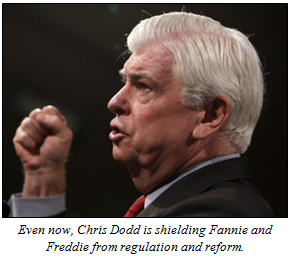Correction: Fannie and Freddie took on some $1.835 trillion in higher-risk mortgages and mortgage-backed securities in June 2008 just before the GSE’s were nationalized, more than the $837 billion previously reported. The $1.835 trillion included high risk loans in whole loan form, most of which, $1.646 trillion, were GSE-issued mortgage-backed securities, and $189 billion of subprime and Alt-A private mortgage-backed securities.
Here we go again.
Last week, defending his latest attempt for the government to take over the nation’s financial system, Senator Chris Dodd said, “This bill has been written specifically to end any notion of any kind of a bailout by the American taxpayer again.”
Dodd’s response was forced by a letter to Senator Harry Reid signed by all 41 members of the Senate Republican Conference who wrote, “As currently constructed, this bill allows for endless taxpayer bailouts of Wall Street.”
To be certain, it is a bailout. And it perpetuates the moral hazard that causes the so-called “too big to fail” financial institutions to take risks they otherwise would not.
How? In part, the bill expressly includes a revolving $50 billion TARP-like fund designed to capitalize failing financial institutions that might otherwise be finding their way to bankruptcy court — where they belong. Republicans are calling it a “permanent bailout fund.”
While the $50 billion price tag appears relatively small to the $700 billion Troubled Asset Relief Program, and is dwarfed for instance by the Federal Reserve’s recently completed purchase of some $1.25 trillion of recently-issued mortgage-backed securities (MBS), it still represents moral hazard of the first order.
It implies that should the fund prove insufficient to shore up a failing institution that it will necessarily be increased ad infinitum — no matter how foolish the institution involved acted.
What’s worse, the bill itself fails to recognize that the implicit backing of the federal government (i.e. moral hazard), and by extension taxpayers — particularly of Fannie Mae and Freddie Mac — largely caused the crisis to begin with.
Because of the implicit backing of taxpayers, Fannie and Freddie securities were automatically given AAA credit ratings, reports former Chief Credit Officer of Fannie Mae, Ed Pinto. Because of that shielding from scrutiny, Fannie and Freddie were able to misrepresent the quality of mortgages that underlined those securities.
Because of the implicit backing, Fannie and Freddie crafted a marketing plan that enabled them to sell some $4.7 trillion of mortgage-backed securities, $1.5 trillion of which were sold overseas to investors, as reported by the New York Times. By promising a higher rate of return than treasuries, but with the same risk associated with a taxpayer guarantee, the sales flooded the GSE’s throughout the housing bubble. As more securities were sold, Fannie and Freddie bought more mortgages and bundled them into securities.
As a direct result, Fannie and Freddie were able to acquire about half of all mortgages as of July 2008. Thus, when the mortgage giants were going bankrupt due to catastrophic losses on the bogus securities — some $1.835 billion of them were of the higher risk variety, and being mislabeled in many cases, the delinquency and default rates were higher than expected — those taxpayer guarantees became explicit.
And the Dodd bill does nothing to rein in this inherent moral hazard. It does nothing to repeal the weakened lending standards that Fannie, Freddie, and the Federal Housing Administration helped to foster. It does nothing to repeal the Clinton-era Community Reinvestment Act regulations that strong-armed banks into making loans that could not be repaid.
Nor does the bill rein in the loose dollar, low interest rate policy of the Federal Reserve that accommodated the housing bubble’s ascent. Instead, it promotes and expands the powers of the Fed to engage in more bailouts, issue more regulations, and do the same thing all over again by keeping the easy money flowing.
So, in short, it does nothing to repeal the moral hazard that forged the crisis to begin with. Not only does it create a new $50 billion bailout fund, it leaves the trillions of dollars in bailouts already enacted in place — with no end in sight. A thoughtful approach to financial reform would have sought to roll back these government guarantees, first by selling off Fannie and Freddie piece by piece.
But instead, Fannie and Freddie are omitted entirely from the bill, and the policies that caused the failure carried on. In fact, a text search of the legislation reveals that the two entities are not even mentioned. At all. How can that be?
It’s a bailout.
Robert Romano is the Senior Editor of ALG News Bureau.


 By
By